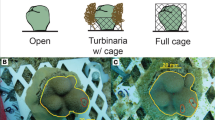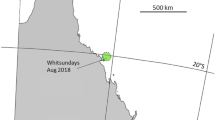Abstract
Capture of zooplankton by scleractinian corals has been noted for several species, yet quantitative information on rates of capture and differential capture by prey taxon has been lacking. We used field enclosures to examine prey capture for two coral species,Madracis mirabilis (Duchassaing and Michelotti) andMontastrea cavernosa (Linnaeus), on the north coast of Jamaica (Discovery Bay) in November 1989, February and March 1990, and January 1992.M. mirabilis has small polyps and a branching colony morphology (high surface/volume ratio), whereasM. cavernosa has large polyps and mounding colonies (low surface/volume ratio). Corals were isolated front potential prey, then were introduced into enclosures with enhanced zooplankton concentrations for 15- to 20-min feeding periods. Corals were fixed immediately after the experiment to prevent digestion, and coelenteron contents were examined for captured zooplankton. Plankton pumps were used to sample ambient zooplankton in the enclosures near the end of each run. Selectivity and capture rates were calculated for each prey taxon in each experiment; both indices were high for relatively uncommon large prey, and low for copepods, which were often the most common items in the plankton. Sizes of zooplankton captured by both species were generally larger than those available considering all prey taxa combined, but were almost the same for both coral species, even though the corals' polyp sizes are very different. This occurred primarily because small copepods, with low capture rates, dominated most plankton samples. For specific prey species, or group of species, there were few significant differences in size between the prey available and the prey captured.M. mirabilis, with small polyps, also captured far more prey per unit coral biomass than didM. cavernosa, with much larger polyps. We hypothesize that the large differences in capture rate of prey taxa are related to escape or avoidance behavior by those potential prey, and to the mechanics of capture, rather than to any selectivity by the corals.
Similar content being viewed by others
References
Abelson A, Miloh T, Loya Y (1993) Flow patterns induced by substrata and body morphologies of benthic organisms, and their roles in determining availability of food particles. Limnol Oceanogr 38: 1116–1124
Alldredge AL, King JM (1977) Distribution, abundance and substrate preferences of demersal reef zooplankton at Lizard Island Lagoon, Great Barrier Reef. Mar Biol 41: 317–333
Alldredge AL, King JM (1980) Effects of moonlight on the vertical migration patterns of demersal zooplankton. J exp mar Biol Ecol 44: 133–156
DiSalvo LH (1971) Ingestion and assimilation of bacteria by two scleractinian coral species. In: Muscatine L, Davis LV (eds) Experimental coelenterate biology. University of Hawaii Press, Honolulu, pp 129–136
Drenner RW, McComas SR (1980) The roles of zooplankter escape ability and fish size selectivity in the selective feeding and impact of planktivorous fish. Am Soc Limnol Oceanogr Spec Symp 3: 587–593
Edmondson CH (1928) The ecology of an Hawaiian coral reef. Bull Bernice P. Bishop Mus 45: 1–64
Emery AR (1968) Preliminary observations on coral reef zooplankton. Limnol Oceanogr 13: 293–303
Fabricius KE, Genin A, Benayahu Y (1995) Flow-dependent herbivory and growth in zooxanthellae-free soft corals. Limnol Oceanogr 40: 1290–1301
Ferraris JD (1982) Surface zooplankton at Carrie Bow Cay, Belize. In: Rützler K, Macintyre IG (eds) The Atlantic barrier reef ecosystem at Carrie Bow Cay, Belize. I. Smithsonian Institution Press, Washington, DC, pp 143–151
Gerritsen J (1984) Size efficiency reconsidered: a general foraging model for free-swimming aquatic animals. Am Nat 123: 450–467
Glynn P (1973) Ecology of a Caribbean coral reef. The Porites reefflat biotope. Part II. Plankton community with evidence for depletion. Mar Biol 22: 1–21
Goreau TF, Goreau NI, Yonge CM (1971) Reef corals: autotrophs or heterotrophs? Biol Bull mar biol Lab, Woods Hole 247–260
Greene CH, Landry MR, Monger DC (1986) Foraging behavior and prey selection by the ambush entangling predator,Pleurobrachia bachei. Ecology 67: 1493–1501
Helmuth B, Sebens KP (1993) The influence of colony morphology and orientation to flow on particle capture by the coralAgaricia agaricites (Linnaeus). J exp mar Biol Ecol 1889: 1–28
Hobson ES, Chess JR (1979) Zooplankters that emerge from the lagoon floor at night at Kune and Midway Atolls, Hawaii. Fish Bull US 77: 275–280
Ivlev VS (1961) Experimental ecology of the feeding of fishes. Yale University Press, New Haven
Jakubczak RS (1989) The nutrition and neurophysiology of reef corals. PhD dissertation, Department of Biology, University of Georgia, Athens, Ga
Johnson AS, Sebens KP (1993) Consequences of a flattened morphology: effects of flow on feeding rates of the scleractinian coxal Meandrina meandrites. Mar Ecol Prog Ser 99: 99–114
Koehl MAR (1977) Water flow and the morphology of zoanthid colonies. In: Taylor DL (ed) 3rd int coxal Reef Symp. University of Miami, Miami, Fla., pp 437–444
Lang JC, Chornesky EA (1988) Competition between scleractinian reef corals: a review of mechanisms and effects. In: Dubinsky Z (ed) Ecosystems of the world: coxal reefs. Elsevier Press, Amsterdam, pp 209–252
Lewis JB (1992) Heterotrophy in corals: zooplankton predation by the hydrocoralMillepora complanata. Mar Ecol Prog Sex 90: 251–256
Lewis JB, Price WS (1975) Feeding mechanisms and feeding strategies of Atlantic reef corals. J Zool Lond 176: 527–544
Liddell WD, Ohlhorst S (1987) Patterns of reef community structure, North Jamaica. Bull mar Sci 40: 311–329
Muscatine L (1973) Nutrition of corals. In: Jones OA, Endean R (eds) Biology and geology of coxal reefs, 2nd edn. Academic Press, New York, pp 79–115
Muscatine L, Porter JW (1977) Reef corals: mutualistic symbiosis adapted to nutrient-poor environments. Bio Sci 27: 454–459
Ohlhorst SL (1982) Diel migration patterns of demersal reef zooplankton. J exp mar Biol Ecol 60: 1–15
Ohlhorst SL (y1985) Reef zooplankton collected along a depth gradient at Discovery Bay, Jamaica. In: Reaka M (ed) The ecology of coxal reefs. NOAA Symp Sex Undersea Res 3: 101–116
Ohman MD (1988) Behavioral responses of zooplankton to predation. Bull mar Sci 43: 530–550
Paffenhöfer G (1991) Some characteristics of abundant subtropical copepods in estuarine, shelf and oceanic waters. Proc 4th int Conf on Copepoda. Bull Plankton Soc Japan 1991: 201–206
Pastorok RA (1981) Prey vulnerability and size selection byChaoborus larvae. Ecology 62: 1311–1324
Pearre SP (1982) Estimating prey preference by predators: uses of various indices and a proposal of another based onλ 2. Can J Fish aquat Sciences 39: 914–923
Porter JW (1974) Zooplankton feeding by the Caribbean reef-building coxal Montastrea cavernosa. In: Cameron et al. (eds) Proc 2nd int coxal Reef Symp.Great Barrier Reef Committee, Brisbane, pp 111–125
Porter JW (1976) Autotrophy, heterotrophy and resource partitioning in Carribbean reef building corals. Am Nat 110: 731–742
Porter JW, Porter KG (1977) Quantitative sampling of demersal plankton migrating from different coxal reef substrates. Limnol Oceanogr 22: 553–556
Porter JW, Porter KG, Batac-Catalan Z (1977) Quantitative sampling of Indo-Pacific demersal reef plankton. In: Taylor DL (ed) Proc. 3rd int. Coral Reef Symp. University of Miami, Miami, Fla., pp 105–112
Porter KG, Porter JW, Ohlhorst SL (1978) Analysis of resident reef zooplankton composition and habits. In: Stoddaxt DR, Johannes RE (eds) Coral reefs: research methods. Monogr oceanogr Methodol (UNESCO) 5: 499–514
Purcell JE, Creswell FP, Cargo DG, Kennedy VS (1991) Differential ingestion of bivalve larvae by the scyphozoan Chrysaora quinquecirrha and the ctenophoreMnemiopsis leidyi. Biol Bull mar biol Lab, Woods Hole 180: 103–11l
Purcell JE, Siferd TD, Marliave JB (1987) Vulnerability of larval herring (Clupea harengus) to capture by the jellyfishAequorea victoria. Mar Biol 94: 157–162
Robichaux DM, Cohen AC, Reaka ML, Allen D (1981) Experiments with zooplankton on coxal reefs, or will the real demersal plankton please come up? Mar Ecol Prog Sex 2: 77–94
Rubenstein DJ, Koehl MAR (1977) The mechanism of filter feeding: some theoretical considerations. Am Nat 111: 981–994
Rützler K, Ferraris JD, Larson RJ (1980) A new plankton sampler for coxal reefs. Pubbl Staz Zool Napoli (I. Mar Ecol) 1: 65–71
Sebens KP (1977) Autotrophy and heterotrophy nutrition of coxal reef zoanthids. In: Taylor DL (ed) Proc 3rd int coxal Reef Symp. University of Miami, Miami, Fla., pp 397–406
Sebens KP (1979) The energetics of asexual reproduction and colony formation in benthic marine invertebrates. Am Zool 19: 683–697
Sebens KP (1987) Coelenterata. In: Vernberg FJ, Pandian TJ (eds) Animal energetics, 1st edn. Academic Press, New York, pp 55–120
Sebens KP, Johnson AS (1991) The effects of water movement on prey capture and distribution of reef corals. Hydrobiologia 226: 91–101
Sebens KP, Koehl MAR (1984) Predation on zooplankton by the benthic anthozoansAlcyonium siderium (Alcyonacea) andMetridium senile (Actiniaria) in the New England subtidal. Mar Biol 81: 225–271
Sebens KP, Mancy EJ Jr (1992) A portable diver-operated plankton sampler for near-substratum use. In: Cahoon LB (ed) Proceedings of the American Academy of Underwater Sciences; 12th Annual Symposium. A.A.U.S., Wilmington, NC
Sebens KP, Witting J, Helmuth B (1996) Effects of branch spacing and water flow on particle capture by the reef coxalMadracis mirabilis. J exp mar Biol Ecol (in press)
Shimeta J, Jumars Pa (1991) Physical mechanisms and rates of particle capture by suspension feeders. Oceangr mar Biol A Rev 29: 191–257
Sokal RR, Rohlf FJ (1981) Biometry, 2nd edn. W.H. Freeman and Company, San Francisco
Sorokin YI (1973) On the feeding of some scleractinian corals with bacteria and dissolved organic matter. Limnol Oceanogr 18: 380–385
Sorokin YI (1991) Biomass, metabolic rates and feeding of some common reef zoantharians and octocorals. Aust J mar freshwat Res 42: 729–741
Tiffon Y (1976) Nutrition experimentale chez les cerianthaires. In: Mackie GO (ed) Coelenterate ecology and behavior. Plenum, New York, pp 147–154
Trager G, Achituv Y, Genin A (1994) Effects of prey escape ability, flow speed, and predator feeding mode on zooplankton capture by barnacles. Mar Biol 120: 251–259
Van Präet M (1980) Absorption des substances dissoutes dans le milieu, des particules et des produits de la digestion extracellulaire chezActinia equina L. Reprod Nutr Dev (Paris) 20: 1391–1399
Vanderploeg HA, Scavia D (1979) Two electivity indices for feeding with special reference to zooplankton grazing. J Fish Res Bd Can 36: 362–365
Wellington GM (1982) An experimental analysis of the effects of light and zooplankton on coxal zonation. Oecologia 52: 311–320
Yen J (1985) Selective predation by the carnivorous marine copepodEuchaeta elongata: laboratory measurements of predation rates verified by field observations of temporal/spatial feeding patterns. Limnol Oceanogr 30: 577–597
Yen J, Fields D (1992) Escape responses ofAcartia hudsonica (Copepoda) nauplii from the flow field ofTemora longicornis (Copepoda). In: Sprules GO, Schulze PC, Williamson CE (eds) Advanced techniques for in situ studies of zooplankton abundance. Plenum, Stuttgart, pp 123–134
Yonge CM (1968) Living corals.Proc R Soc (Ser B) 169: 329–344
Yonge CM, Nicholls AG (1931) Studies on the physiology of corals. V. The effect of starvation in light and in darkness on the relationship between corals and zooxanthellae. Scient Rep Gt Barrier Reef Exped 1: 177–211
Author information
Authors and Affiliations
Additional information
Communicated by J.P. Grassle, New Brunswick
Rights and permissions
About this article
Cite this article
Sebens, K.P., Vandersall, K.S., Savina, L.A. et al. Zooplankton capture by two scleractinian corals,Madracis mirabilis andMontastrea cavernosa, in a field enclosure. Mar. Biol. 127, 303–317 (1996). https://doi.org/10.1007/BF00942116
Received:
Accepted:
Issue Date:
DOI: https://doi.org/10.1007/BF00942116




